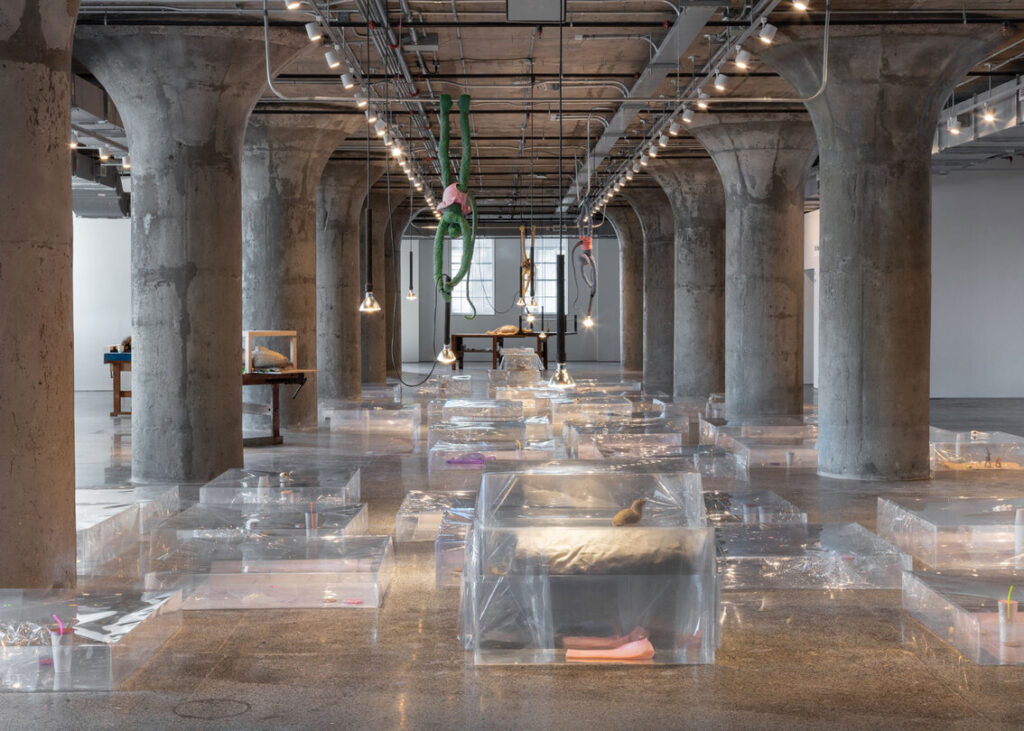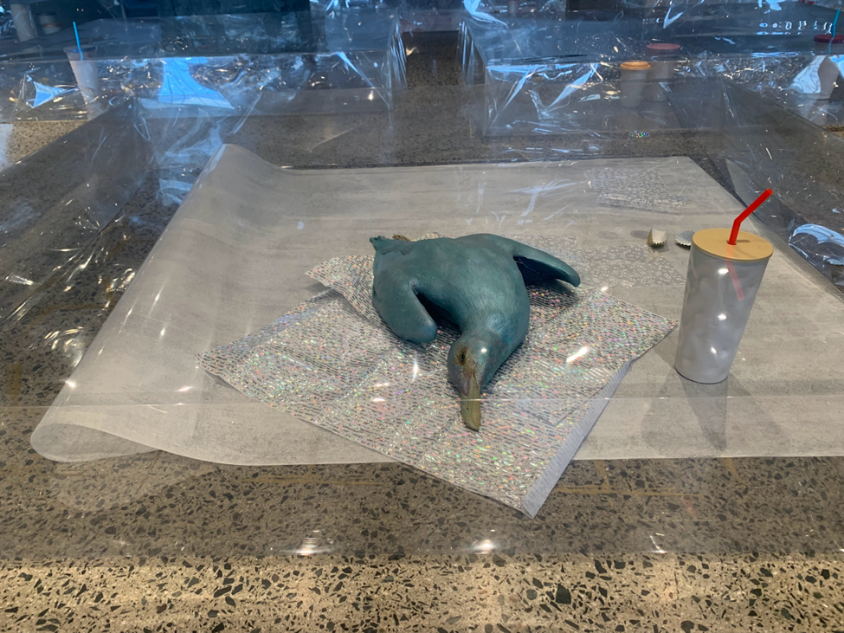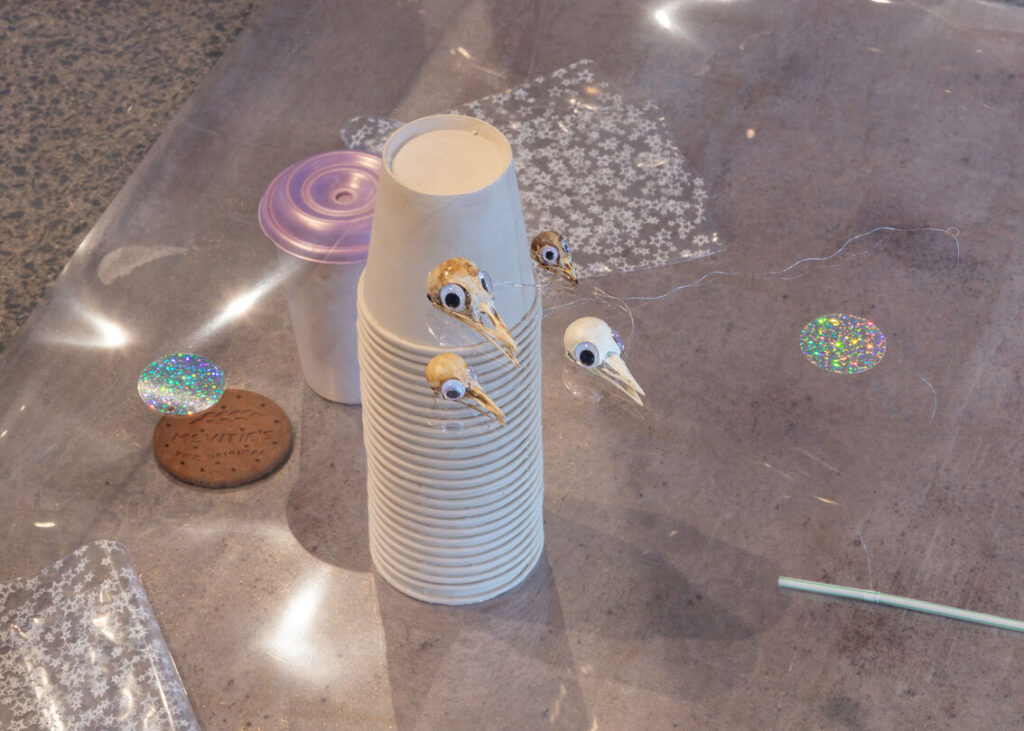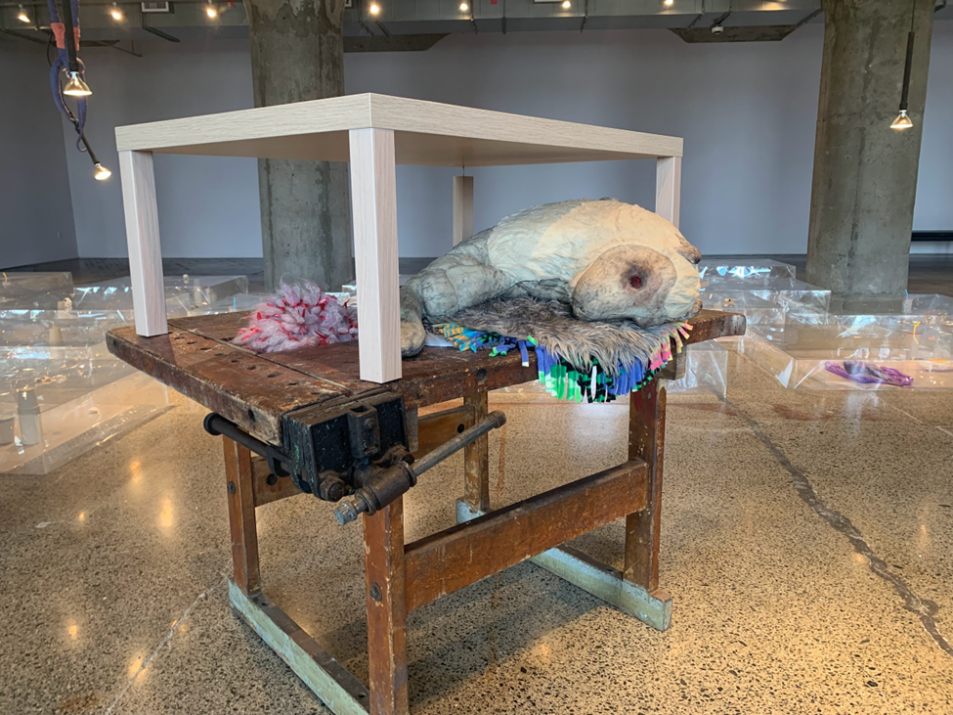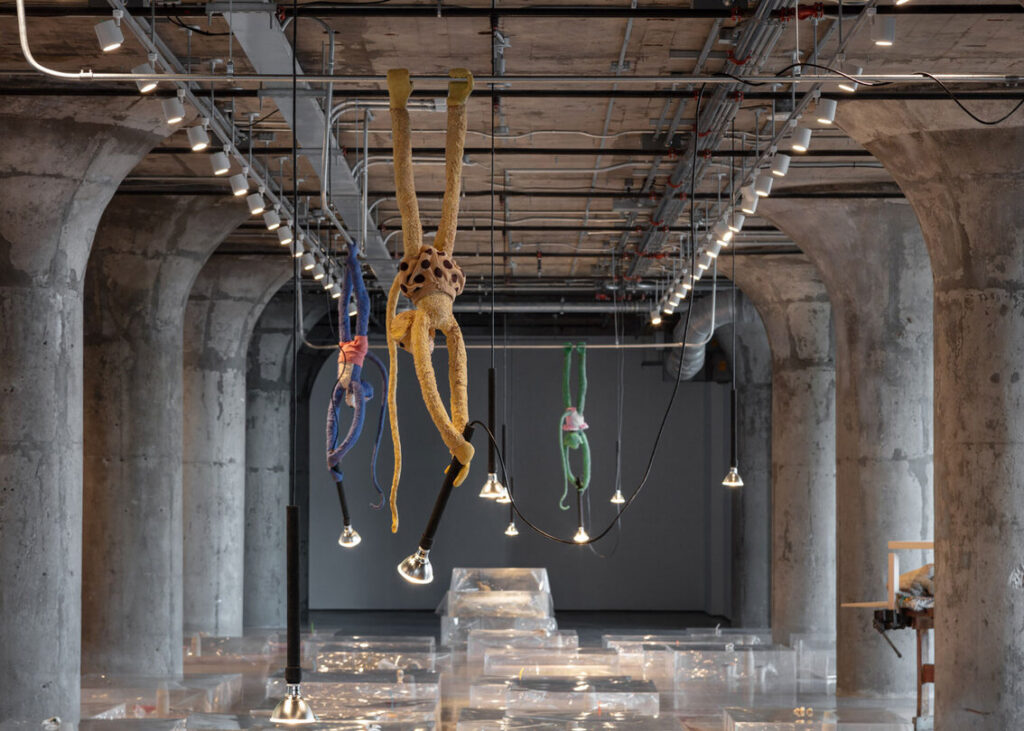A long arrangement of mylar boxes glitters below dangling lights, some held by monkeys. Spilling across the middle of the Museum of Contemporary Art’s second floor, these boxes – or the stream – divide the room into two embankments. Their placement mimics the nature of a river: flowing across the concrete floor and pushing up against the pillared shores, some boxes are stacked, rising the water levels like waves. Then, the inlet deviates to the side and enters a new part of the room, trickling off.
With over four decades of experience, Liz Magor is an important figure in contemporary Canadian Art. Based in Vancouver, she has taught at OCADU and the Emily Carr University of Art and Design. Greatly interested in ontology (the very nature of being), the objects of our day-to-day lives are questioned, reconceptualized, and re-presented by her art. Liz Magor’s work showcases the many possibilities sculpture can have as a narrative form. “The Separation” is a powerful narrative, inspiring dialogue about the material world.
Liz Magor, The Separation, 2023. Installation view, MOCA Toronto. Courtesy the artist, Andrew Kreps, Catriona Jeffreys, and Collection of Francois R. Roy. Photo: Laura Findlay
Despite the ease with which the stream moves, there are layers of tension permeating the installation: Magor fixes rough against refined; luxe against cheap; custom-made against mass-produced; impermanence against permanence; ebb against flow. A prime example is the boxes themselves: made from mylar, this flexible yet durable material shimmers whimsically in the light, but its message of consumption and excess undercuts the allure. One box is alight with disco confetti, yet there is little to celebrate when the eye falls on a moulded bird lying lifelessly on a bed of cheerful tissue paper. The plastic imagery, shiny and playful, is countered by the mortal undertones of lifeless animals. Contradictions like these can be found abundantly in this exhibition.
Liz Magor, The Stream, 2023, mylar boxes and found material. Installation view of The Separation at MOCA Toronto. Photo: Elin MacRae
Each box contains an array of seemingly random items: found objects, past their expected life-cycles, have been reanimated and repurposed, erasing the “out of sight, out of mind” mentality associated with our thrown-away trappings. One box features take-away cups, their fluorescent straws poking out from the mylar as though breaking a fourth wall. Another box has glitter-y wrapping paper cushioning the corpse of an iridescent pigeon. Some boxes have stacked cups and animal figurines. All items about which one would not think twice once discarded have returned in this exhibition to force the viewer to look again and ponder. Which of these items were found, which were created? The cast items, facsimiles of everyday utility, catch the viewer’s eye in a double-take: is that real? Is it trash, or a cast? If it is a cast, does that make it any less the object it replicates? Ontological questions like these fuel Liz Magor’s art: she wants viewers to look and then re-look.
Liz Magor, The Stream, 2023, mylar boxes and various found materials. Installation view, MOCA Toronto. Courtesy the artist, Catriona Jeffreys, Vancouver. Photo: Laura Findlay
The imagery of deceased birds brings to mind photographer Chris Jordan’s “Midway: Message from the Gyre,” which captures decaying albatrosses with stomachs full of plastic. Perhaps in conversation with one another, both artists’ works encourage dialogue about the true impact of plastic waste and materialism. Additionally, something as ubiquitous as birds makes their narration accessible to all: just like with takeout cups and Tupperware, birds are a part of the everyday, so much so that we rarely cast them a second thought. But here, Magor is forcing that second thought – even a third or fourth.
The course of the stream is interrupted by three smaller installations, known as boulders. Juxtaposed with the fast movement of the shimmering mylar boxes, these boulders act as a standstill, a moment of rest from the flow of the art. “Float,” the largest boulder situated at the beginning of the current, acts as a calm before the cascading mylar pours over the floor and against the other boulders. Two tables, one balancing upside down atop the other, frame a goose painted an iridescent pearl. Its restful placement on the pelts of another animal feels deliberate, careful. The lower level of the table is busy with stacks of plastic cups, seashells, Tupperware, and metal tins, precious objects to a scavenger. Another boulder, “Stall,” sets a stiff, near-taxidermized giraffe on a worktable, sewn together with care. The touches of spilled coffee and strewn-about work pieces suggest a recent departure, as though our worker was just here. The last boulder, “Drift,” similar to its counterparts, features a stuffed animal, its chasmic and bloodied eye sockets a jarring break from the glisten and dance of the stream beside it. What looks like bloodied cotton sits in a pile next to the stitched underbelly of the animal, as though its innards have been slopped out and left to observe alongside the art. It is tensions like these that elevate the dynamism of the installation.
Liz Magor, Drift, 2021, silicon rubber, polyester, work-bench, coffee table. Installation view of The Separation at MOCA Toronto. Photo: Elin MacRae.
Looking up, it becomes clear the installation’s lighting is just as in-conversation with the stream as the boulders. Warm and seductive lights illuminate and flatter the boxes the way one would experience at the mall, shopping for the latest trends. Three monkeys dangle from the ceiling fixtures, holding and pointing their own lights as if to say: “Look here! Look at this one! And this one!” To this author, Liz Magor’s wry humour is emerging: we are the monkeys, shining a glamorous light on consumerism and material waste. Yet again, the artist finds another avenue to create tension by posing death against the levity of her wit.
Liz Magor, The Separation, 2023, Installation view, MOCA Toronto. Courtesy the artist, Andrew Kreps, Catriona Jeffreys, and Collection of Francois R. Roy. Photo: Laura Findlay
Consider this exhibition’s title: “The Separation,” and the implicit question about what separation truly is. A plain interpretation could be the separation of the MOCA’s second floor by the stream and boulders; a more subtle one might suggest the separation between us and our thrown-away objects. How might one react or feel when their discarded leavings come back to face them once again? When “out of sight, out of mind” no longer applies to plastic and material waste, what then? In a time of changing values and shifting fates, Liz Magor invites you to look and re-look at your familiar and the life you may bring to the everyday things which are otherwise taken for granted.
By Elin MacRae
*Exhibition information: Liz Magor: The Separation, September 7, 2023 – February 4, 2024, MOCA, 158 Sterling Ave, Toronto. Museum hours: Wed – Thu & Sat – Sun 11 am – 6 pm; Fri 11 am – 9 pm.

